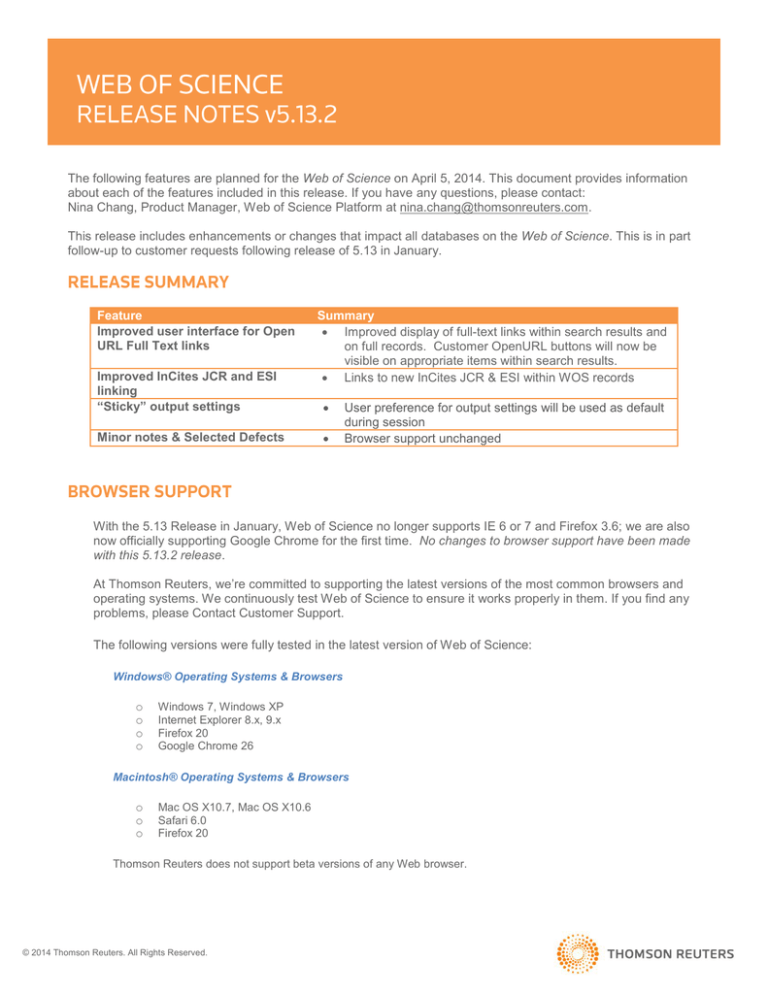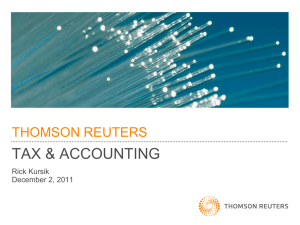
The following features are planned for the Web of Science on April 5, 2014. This document provides information
about each of the features included in this release. If you have any questions, please contact:
Nina Chang, Product Manager, Web of Science Platform at nina.chang@thomsonreuters.com.
This release includes enhancements or changes that impact all databases on the Web of Science. This is in part
follow-up to customer requests following release of 5.13 in January.
Feature
Improved user interface for Open
URL Full Text links
Improved InCites JCR and ESI
linking
“Sticky” output settings
Minor notes & Selected Defects
Summary
Improved display of full-text links within search results and
on full records. Customer OpenURL buttons will now be
visible on appropriate items within search results.
Links to new InCites JCR & ESI within WOS records
User preference for output settings will be used as default
during session
Browser support unchanged
With the 5.13 Release in January, Web of Science no longer supports IE 6 or 7 and Firefox 3.6; we are also
now officially supporting Google Chrome for the first time. No changes to browser support have been made
with this 5.13.2 release.
At Thomson Reuters, we‟re committed to supporting the latest versions of the most common browsers and
operating systems. We continuously test Web of Science to ensure it works properly in them. If you find any
problems, please Contact Customer Support.
The following versions were fully tested in the latest version of Web of Science:
Windows® Operating Systems & Browsers
o
o
o
o
Windows 7, Windows XP
Internet Explorer 8.x, 9.x
Firefox 20
Google Chrome 26
Macintosh® Operating Systems & Browsers
o
o
o
Mac OS X10.7, Mac OS X10.6
Safari 6.0
Firefox 20
Thomson Reuters does not support beta versions of any Web browser.
© 2014 Thomson Reuters. All Rights Reserved.
Important note for Windows XP users of Internet Explorer 8:
Please download the KB2416400 patch (available here: http://search.microsoft.com/enus/DownloadResults.aspx?q=KB2416400) if you receive the error “HTML Parsing Error: Unable to modify the
parent container element before the child element is closed (KB927917).”
.
Within the Summary (search results) page we have ungrouped the full-text links and Web of Science will now
display the appropriate links directly below the summary result. This is particularly relevant to the display of an
institution‟s OpenURL link resolver which is often accompanied by an easily recognizable “Find it at X” custom
button. This change will also eliminate the need to click to open the full-text link and then click again on the
appropriate link.
On the summary results page we will now show up to two links to full-text. If an OpenURL resolver is configured
that will display first. If another link is configured and presentable, such as a link to the „Full Text from Publisher‟
or a link to „Order Full Text‟, that link will also be presented.
On the full record page for the article, if there is only one link to full text, that link will be displayed. If there are
multiple links to the full text those will be displayed within a Full Text Options dropdown selector.
The images below show how this will be displayed in 5.13.2. This image below shows multiple options including
one with an SFX link which represents an OpenURL link resolver.
© 2014 Thomson Reuters. All Rights Reserved.
This image below depicts a variety of potential link displays at the top of a full record when there is only one link
to full-text. The first example shows the display if the article only has one full-text link to the institution‟s OpenURL
linkresolver.
© 2014 Thomson Reuters. All Rights Reserved.
The images below show how the Full Text Options are displayed when there are multiple links associated with an
article. A „Full Text Options‟ button will display with a drop-down arrow indicator.
© 2014 Thomson Reuters. All Rights Reserved.
For InCites JCR and ESI customers, we have updated the links in the article Full Record to access those new
InCites product sites. This will be displayed in the Journal Information section in the body of the Full Record page.
The “Impact Factor” and “Performance Trends” product name links will appear for the user only if they subscribe
to JCR or ESI, respectively.
Based on entitlements, if we identify that the user subscribes to the previous version of JCR or ESI, the links will
continue to connect to those products. If we identify that the user has access to InCites JCR and ESI, the links
will take the user to the appropriate new version.
•
•
The JCR link will continue to display the 5-year trend graph for the journal.
The ESI link will continue to display the document page for the record.
© 2014 Thomson Reuters. All Rights Reserved.
The output function for saving results sets includes the ability to export records in a number of different formats.
When a user changes the setting to select an alternate output format this selection will be retained for the duration
of the session as the user navigates to additional pages across the Web of Science.
See image below. This is an example of the default choice showing Save to EndNote online. If the user selects
another choice, then the default output becomes that choice for the remainder of the session or until they change
it.
As noted above the Web of Science no longer supports IE6 and IE7 and will also not work properly if a newer
version of IE browser is set to Compatability View mode. The Web of Science will prompt users to change
browsers if they are using an unsupported browser.
Web of Science no longer supports Internet Explorer 6 or 7 or Internet Explorer 8 or 9 when
running in Compatibility View. Please upgrade your browser or turn off Compatibility View. For
IE 8 or 9 users, please hit F12 and verify that your Browser Mode is not set to Compatibility
View.
This release also fixes several reported defects including:
The input box for Alert email addresses has been expanded to accommodate up to 1500 characters
Display issues associated certain pages when the Japanese and Chinese language interfaces are used
have been fixed
© 2014 Thomson Reuters. All Rights Reserved.




